CESTODES (Tape Worms) TAENIA SAGINATA ,TAENIA SOLIUM ,Neurologic manifestations of cysticercii (neurocysticercosis)
Tapeworms, or cestodes, are hermaphroditic flatworm parasites, which can live as parasitic adults in the human gastrointestinal (GI) tract. Cysticercosis is caused by the larval stage (metacestode) of the pork tapeworm Taenia solium.
- A genus of tapeworms, parasitic flatworms belonging to the class Cestoda, phylum Platyhelminthes.
- Clinical syndromes related to this parasite are divided into neurocysticercosis (NCC) and extraneural cysticercosis.
- A genus of tapeworms, parasitic flatworms belonging to the class Cestoda, phylum Platyhelminthes.
 |
| CESTODES (Tape Worms)TAENIA SAGINATA,TAENIA SOLIUM |
Cestodes or tapeworms are segmented worms.
- The adult worms live in the GIT but their larva can invade any organ.
Human tape worms are of three groups:
- 1. Humans are definitive hosts and the adult worms live in the GIT exs. Taenia saginata, Diphyllobothrium, Hymenolepis.
- 2. Humans are intermediate hosts and the larval stages are found in the tissues. Exs. Echinococcosis, Sparganosis, Coenurosis.
- 3. In Taenia solium infection, man may be definitive or intermediate host.
TAENIA SAGINATA
- The adult worm lives in the small intestine of humans, who acquire it by eating insufficiently cooked beef infested with the encysted larval form (cysticercus or bladderworm).
- A tapeworm whose larvae live in cattle.
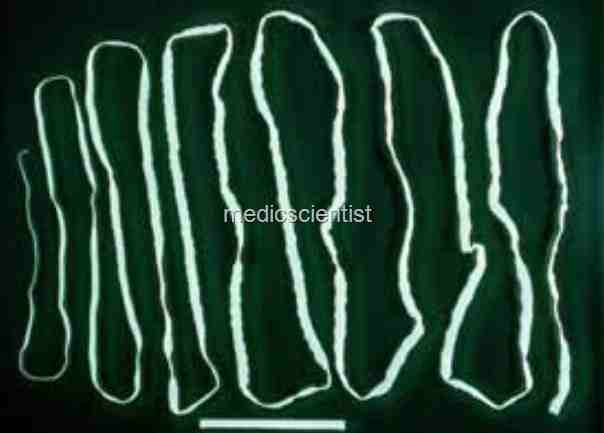 |
| TAENIA SAGINATA |
- It is called Beef tapeworm.
- It occurs due to eating raw or uncooked meat or beef. In India, pigs are the intermediate host.
Etiology:
- · Humans are the only definitive host.
- · The tapeworm lives in upper jejunum and has a scolex with 4 suckers.
- · Eggs from the proglottids are deposited outside, and eaten by cattle and pigs.
- · The embryo released in the cattle or pigs is carried to striated muscle and changes into cysticercus.
- · This is eaten as raw meat and infects man.
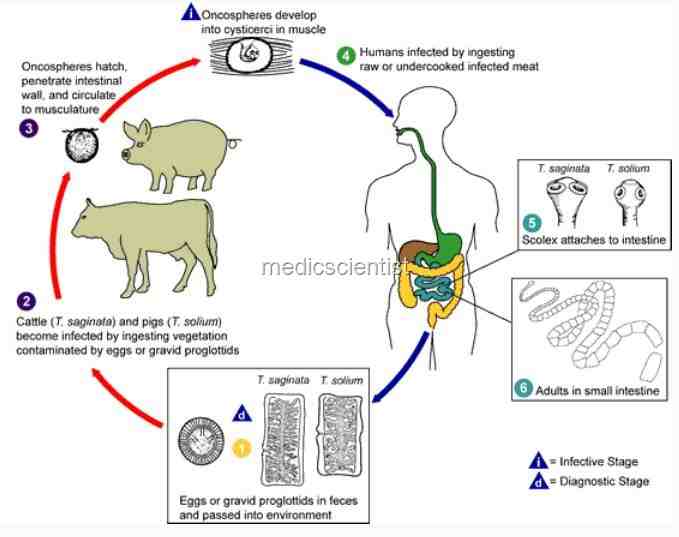 |
| TAENIA SAGINATA and TAENIA SOLIUM Life cycle |
Clinical features:
- Most individuals with diphyllobothriasis are asymptomatic.
- · There is passage of proglottids of the worm in faeces.
- Nonspecific symptoms that have been attributed to infection include numbness, dizziness, fatigue, diarrhea, and allergic symptoms.
- · There is perianal discomfort when the proglottids are passed in stools.
- A peripheral eosinophilia of 5 to 10 percent may occur in some infected patients.
- · There is pain in abdomen, nausea, weakness, weight loss.
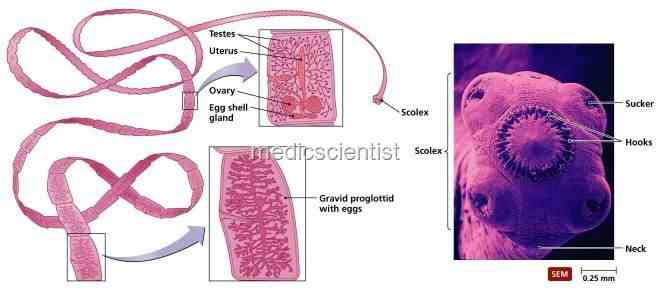 |
| TAENIA SAGINATA |
Tape Worms Diagnosis:
- Megaloblastic anemia and B12 deficiency can be a clue to the diagnosis of diphyllobothriasis.
- · Eggs can be examined in stool.
- Concentration methods are not necessary for diagnosis in most cases, since there are typically high numbers of eggs present in the stool.
- · Cello-tape swab from perianal region can show eggs under microscope.
Treatment of Tape Worms
- The first line treatment for all of these tapeworm infections is praziquantel.
- Praziquantel induces ultrastructural changes in the teguments of parasites, resulting in increased permeability to calcium ions, ultimate paralysis of adult worms.
- Now they dislodgement from intestinal sites and subsequent expulsion by peristalsis.
- Praziquantel – 10mgjKg single dose
Prevention of Tape Worms :
- · Meat should be well-cooked before eating.
- · Refrigeration or salting for long time also kills cysticerci.
TAENIA SOLIUM
Tissue cysticerci develop over a period of three to eight weeks following ingestion of T. solium eggs shed in the stool of a human tapeworm carrier.
 |
| TAENIA SOLIUM |
- This is the pork tapeworm.
- Humans are infected with adult tapeworms which live in the intestine.
- Humans may also be infected with the larval form of Taenia solium in the tissues.
- This is called cysticercosis.
- Humans are the only definitive hosts for T. solium and pigs are intermediate hosts.
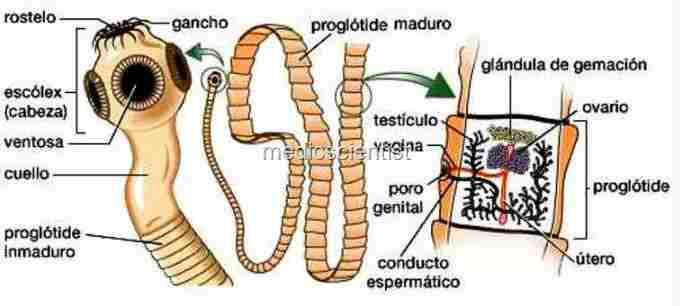 |
| TAENIA SOLIUM Structure |
TAENIA SOLIUM Etiology :
- · The adult worm lives in upper jejunum.
- · The scolex has 2 rows of hooklets.
- · After the eggs are eaten by pigs, the larva from the eggs penetrate the intestine and go to the muscles of neck, trunk and tongue.
- · These develop into cysticercii. When man eats pork containing cysticercii, taeniasis infection occurs. Infection can also occur by eating T. solium eggs.
- · Autoinfection also occurs by eating the eggs of tapeworm from one’s own intestine by ingesting the eggs from faeces, due to not washing the hands properly after defecation.
Clinical features of TAENIA SOLIUM:
- · Asymptomatic
- · Epigastric pain
- · Nausea
- · Weight loss
- · Diarrhea
- · Passage of proglottids in feces
- · Cysticercii may be found in brain, skeletal muscle, subcutaneous tissue or eyes.
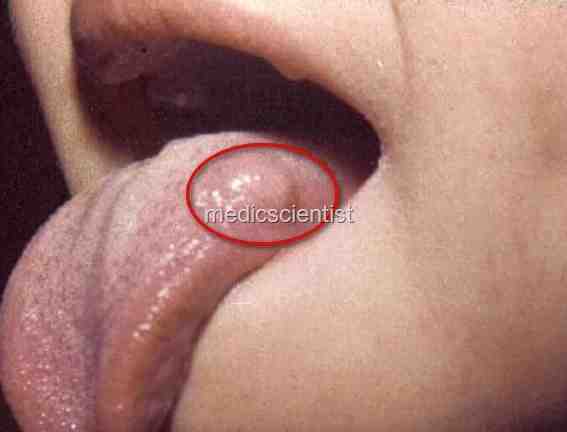 |
| Neurologic manifestations of cysticercii(neurocysticercosis) |
Neurologic manifestations of cysticercii (neurocysticercosis) :
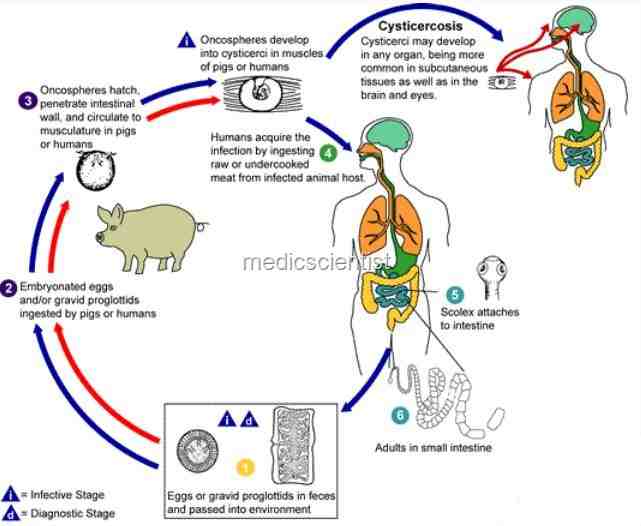 |
| Neurologic manifestations of cysticercii(neurocysticercosis) |
Cysticercosis is caused by the larval stage (metacestode) of the pork tapeworm Taenia solium. Neurocysticercosis, in turn, is divided into parenchymal and extraparenchymal forms.
- · Seizures – Generalized, focal or jacksonian.
- Tissue cysticerci develop over a period of three to eight weeks following ingestion of T. solium eggs shed in the stool of a human tapeworm carrier.
- The clinical manifestations depend on the location and number of parasites and the associated inflammatory response
- The clinical manifestations depend upon whether the cysts are localized to the brain parenchyma, the extraparenchymal tissues, or both.
- · Hydrocephalus – Increased intracranial pressure, giving rise to headache, nausea, vomiting, ataxia, confusion.
- · Chronic meningitis or arachnoiditis.
- Fever is not typically present. Neurologic examination usually does not demonstrate focal signs in the absence of mass effect or stroke.
- · Strokes.
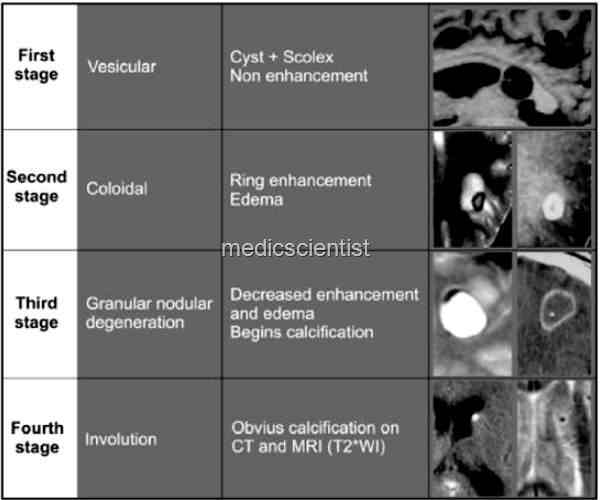 |
| Neurologic manifestations of cysticercii(neurocysticercosis) Stages |
CLINICAL MANIFESTATIONS of neurocysticercosis —
- The clinical manifestations depend upon whether the cysts are localized to the brain parenchyma, the extraparenchymal tissues, or both.
- headache, nausea, and vomiting) and may be accompanied by altered mental status.
- extraparenchymal cysts are associated with symptoms of elevated intracranial pressure
- In general, parenchymal cysts are associated with seizures and headache,
Diagnosis neurocysticercosis:
- · Examination of stools for eggs and proglottids.
- · Detection of parasite in tissues by histopathology.
- · Detection of parasite in eyes by fundoscopy.
- Evaluation of imaging studies in endemic areas has suggested that most parenchymal neurocysticercal infections never cause symptoms;
- · Neuroimaging for cysts containing scolex – Cystic lesions with ring enhancement, nodular calcification may be seen on CT (calcified lesions) or MRI (cystic lesions).
- · Antibodies to cysticercii.
- · Immunoblot assay.
Treatment of neurocysticercosis
- 25 mg/kg in a single dose is given for hymenolepiasis and repeated in 10 days, also with a >95 percent efficacy.
- 5 to 10 mg/kg in a single dose is administered for taeniasis (T. saginata and T. solium) and diphyllobothriasis; efficacy is >95 percent.
- Praziquantel – 10 mgjKg (single dose)
- Niclosamide – 2g (single dose)
- Antiepileptics for seizures
- For neurocysticercosis – Praziquantel 50 mgjday in 3 divided doses for 15 days
- or Albendazole 15 mg/kg/day for 2 wks.
- For obstructive hydrocephalus – endoscopic surgery, ventriculo-peritoneal shunting.
- Glucocorticoids for drug reactions, arachnoiditis, vasculitis.
Prevention neurocysticercosis:
- Because praziquantel kills adult worms but not eggs, precautions should be taken to prevent autoinfection,
- · Personal hygiene
- · Proper disposal of faeces.

